Pesto Genovese is an iconic basil pesto sauce originated in Ligurian Riviera. It is typically used to dress pasta dishes, gnocchi, soups, salads and more!
To eat Pesto Genovese it is to dive into the distinctive flavors of Liguria, the beautiful region between the mountains and the sea where it comes from.

Easy and utterly delicious, this basil pesto embodies the essence of Italian cuisine: few fresh and simple ingredients balanced so well they make your taste buds dance.
Table Of Contents
What does Pesto taste like?
Fresh basil leaves give pesto a distinct herby taste with slightly spicy notes of garlic and its aroma.
Pine nuts add a subtle nuttiness, paired with the cheese to create a creamy texture. Extra virgin olive oil gently enfolds all the ingredients together creating an unforgettable combination of flavor and aroma.
The thing with pesto is that it's never exactly the same. The way you mix the sauce makes a huge difference, so you can get very different results with the same ingredients.
The key to a good Pesto Genovese is that no ingredient should be overwhelmingly dominant. It's all about balancing all flavors well enough so you can tell each one apart.

Did You Know? While basil pesto is the most famous of Ligurian pesto recipes, it's not the only one. Fava Bean Pesto (Maró) is another delicious springtime pesto originated in this region.
Ingredients
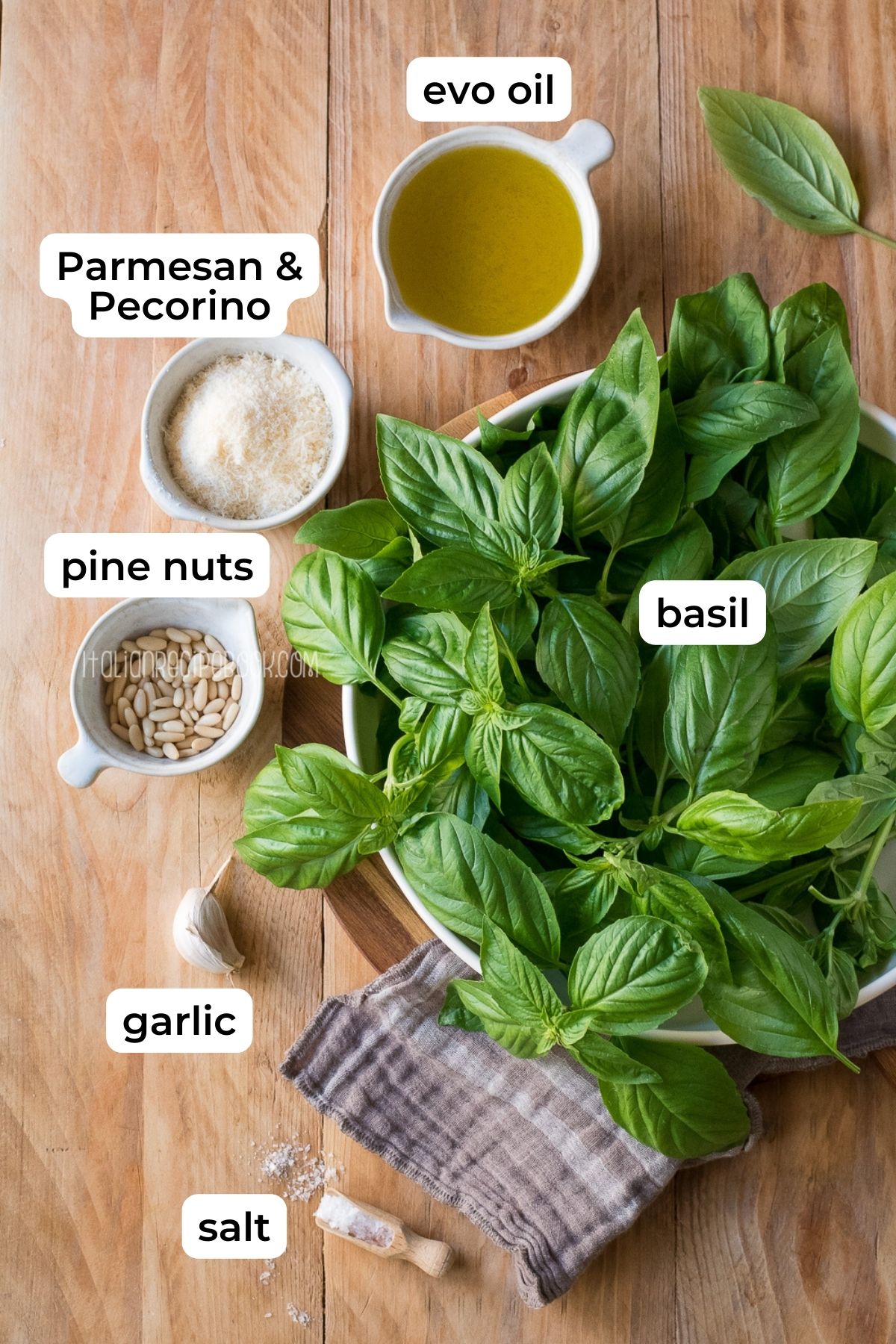
- Fresh Basil Leaves - fresh basil leaves, free of blemishes and without stems. Basil leaves should be completely dry when you start making pesto so make sure to wash or wipe it a little in advance and let air dry before use. See more tips on preparing basil below.
- Pine Nuts - quality pine nuts, you can easily get them at the store or online.
- Garlic Clove - fresh garlic clove with inside germ removed. If you don’t like garlic you can use half or a quarter of a garlic clove but I don’t recommend omitting it completely (even though some still do so). If you like a little stranger garlic taste you can either use a large garlic clove or 2 small cloves but not more than that to keep the balance of all the flavors in pesto sauce.
- Parmesan & Pecorino Cheese - Parmiggiano Reggiano Cheese and Pecorino (Fiore Sardo) are the best choice. Pecorino Sardo might be hard to find outside Italy so it’s possible to use other quality type of Pecorino. Parmiggiano Reggiano can be substituted with Grana Padano cheese and I highly recommend avoid any immitations.
- Extra Virgin Olive Oil - use the best quality extra virgin olive oil you can find. Among commercially available extra virgin olive oils this is my absolute favorite brand.
- Salt - use regular sea salt.
How To Make - Step By Step
IMPORTANT: If you want to maintain the bright green color of your pesto for longer, do this:
- Fill a 2-4 cubes in an ice tray with extra virgin olive oil and freeze. Use as directed in the recipe.
- Place all dry ingredients in the fridge at least 30 to 60 minutes before making pesto to help keep it as green as possible.
To make pesto that never turns brown (even after cooking!) read the special section below.
Prepare the basil
When making pesto it’s essential that your basil leaves are completely dry. There are a few ways how you can prep basil for pesto.
- Wash basil quickly under cold running water an hour or more before making pesto. Shake off access water and place basil (still with stems) in a glass with water (to avoid wilting) and let air dry. When ready to use pinch off all the leaves and discard the stems.
- If you don’t have time to let basil air-dry you can gently wipe the leaves with a damp cloth and than again with a paper towel.
- If you are using homegrown basil it’s best to wash it while it’s still in the soil. Let air dry, cut the basil just before using it (make sure basil is not in direct sunlight a few hours before cutting or it’ll fade fast).
Making Basil Pesto In A Food Processor
Step 1: Cut garlic clove in half and remove the germ (core) if it has one.
NOTE: freshly picked garlic won't have it.
Place it in a food processor together with pine nuts and cheese. Pulse quickly until you get rough grainy texture. Make sure to scrape the bowl a few times.
Do NOT overpulse.
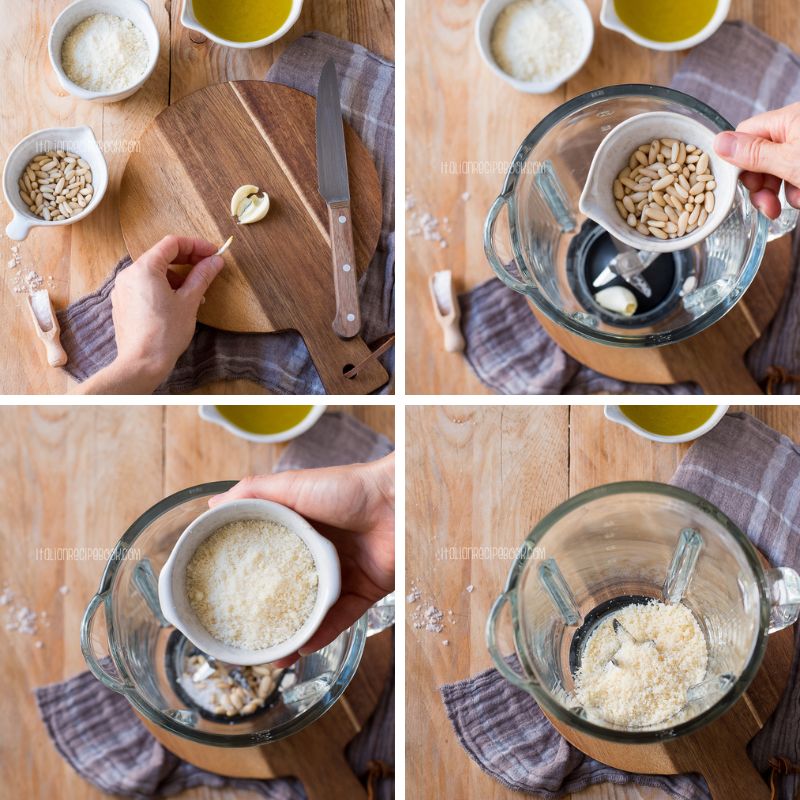
Step 2: Add basil leaves, salt and oil. Pulse quickly scraping the sides of the bowl. Add 1-2 ice cubes or oil cubes that you froze in advance.
Pulse again until you get the creamy paste. Make sure to stop a few times to avoid over heating. Scrape the side of the bowl as/if needed to blend all ingredients together.
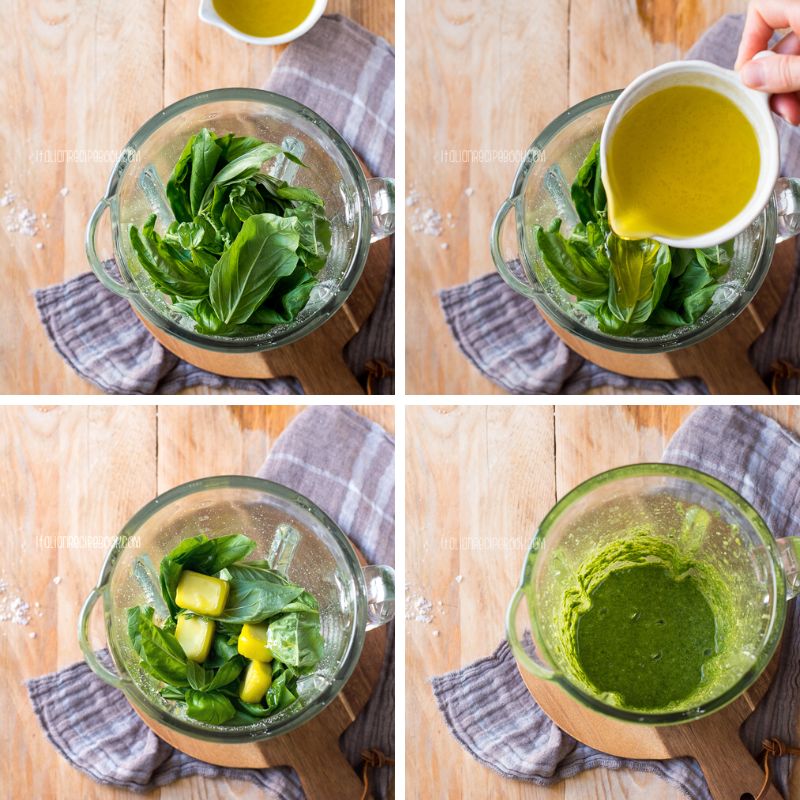
Making Basil Pesto With Mortar & Pestle
Use young (small basil leaves), use marble or stone mortar and pestle. Avoid using wooden pestle.
The process of making Pesto Genovese with classic marble mortar and pestle is slightly different than making it in the food processor.

- Remove the germ from the garlic clove. Cut garlic in smaller pieces, this will make it easier to smash. Work it with a pestle until you get a smooth paste.
- Add pine nuts and mash them with garlic. As a result you should have creamy but still slightly grainy consistency.
- Add a handful of basil leaves and salt grains. Crush the leaves performing rotating motion with the pestle or rotating the mortar itself. That’s the reason why some mortars have handle on the sides to help with rotation.
- Once there’s room in the mortar add the next handful of basil leaves and continue to crush the leaves and add more until you’ve used up them all.
- Lastly add half of all grated cheeses and a splash of extra virgin olive oil. Continue to blend all the ingredients and add more oil and cheese until you get the desired consistency and color. I find that when making pesto with mortar I use a little less of cheese and oil so don’t worry if you have to do the same.
How To Make Pesto That Never Turns Brown
While it's pretty easy to make pesto that keeps its bright green color in cold dishes, it's impossible to prevent pesto from turning brown when it comes in contact with hot ingredients, such as pasta.
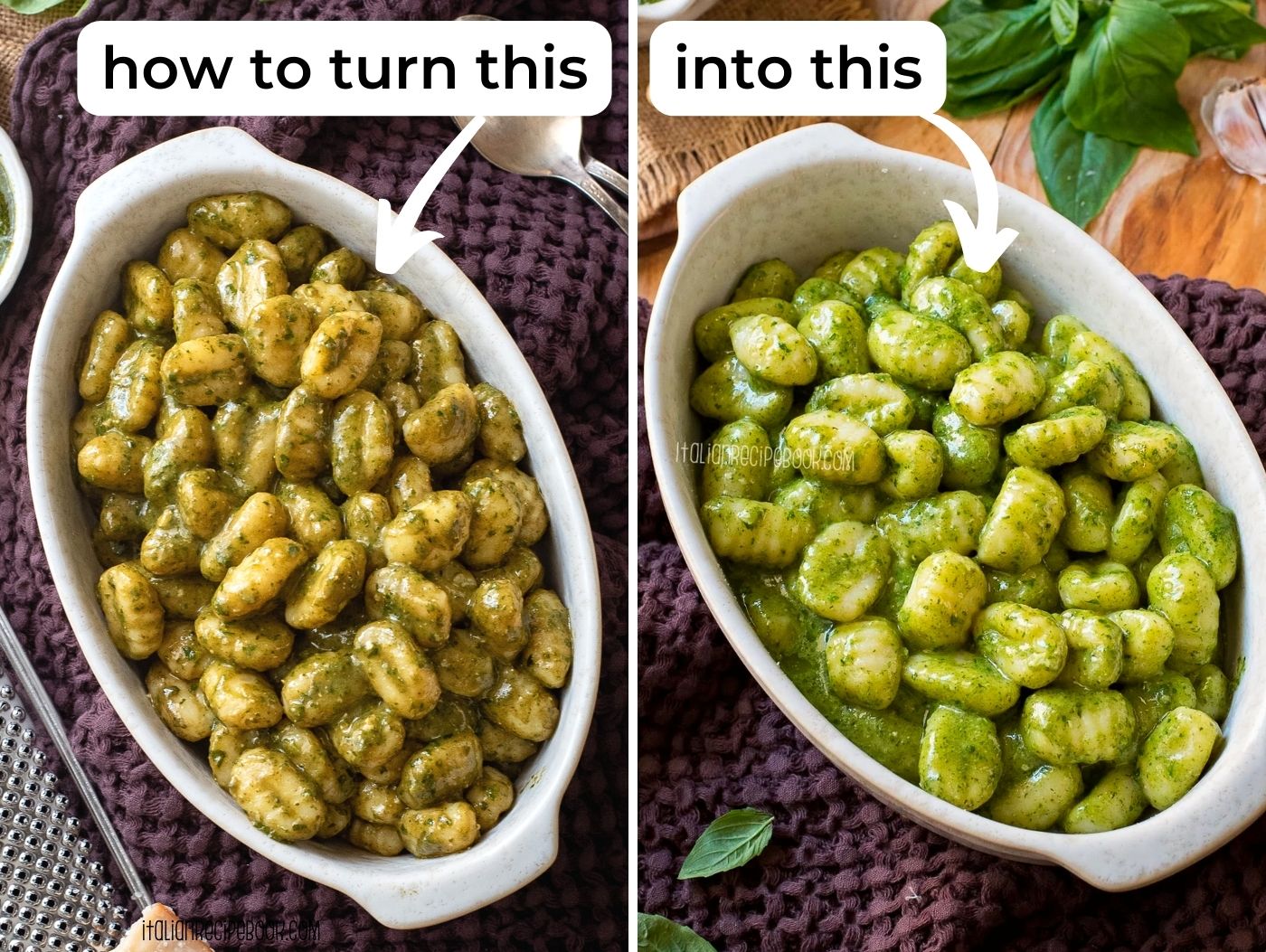
But there's one trick you can use to make sure your pesto ALWAYS stays green. It's especially important when you plan to serve past al pesto to the guests. While the taste of pesto that turned brown will be the same (if not better!), we first eat with our eyes. This means, visually bright green pesto will be always the winner.
This technique is called blanching. You will need a pot with boiling water, a strainer and a bowl filled with cold water and ice.
What this simple process does is it deactivates the enzymes in basil that are responsible to oxidation and hence brown color.
- Bring a pot of water to a boil. Drop ⅔ of all basil leaves in hot boiling water and cook for 5 SECONDS.
- Using a strainer remove the leaves from the pot quickly and immerse them in a bowl filled with cold water and ice to stop the further cooking process.
- Using your hands, squeeze the leaves gently but firmly to remove access water. Now they're are ready to be added to the blender with the remaining ⅓ of basil leaves that you left untouched.

IMPORTANT: Blanch ONLY ⅔ of all basil leaves, keeping ⅓ raw as they are. Fresh basil leaves provide intense flavor and aroma as opposed to blanched ones. Boiling ⅔ of the leaves and keeping ⅓ of them untouched is the best compromise between visual attractiveness and flavor.

Extra Tips
- Double the ingredients. If your food processor has a large bowl it’s easier to double the ingredients and make a bigger batch. You can always preserve extra pesto in the freezer for a couple of month.
- Refrigerate tools and ingredients. Place the food processor blade in the freezer and all ingredients in the fridge 30 to 60 minutes before making pesto so that your pesto turns out bright green and not brown.
- Small or large basil leaves. Use a mix of young (small) leaves and larger leaves if you make presto with a food processor. When making pesto with mortar and pestle use young tender leaves only. It’s much harder to work large leaves with a pestle since they have harder stem (fiber) and you might end up having “threads” in your pesto.
5 Mistakes To Avoid
- Using the wrong ingredients or unacceptable substitutes. Absolutely avoid using parsley (or other herbs), cashews, lemon juice or any other kind of cheese except Parmesan (Grana Padano is a passable option) and Pecorino to make Pesto Genovese. Or simply don’t call it Pesto Genovese.
- Overpowering with one of the ingredients. Remember in Pesto Genovese all ingredients are perfectly balanced. You can feel them all but none is covering the taste of the other.
- Using basil leaves that are not completely dry.
- Over processing your pesto. Food processor blades heat up as you make pesto, excess heat “cooks” the basil and turns it brown. The key is to use “pulse” mode and stop frequently.
- Not using high-quality extra virgin olive oil. Low-quality oil can drastically change basil pesto taste making it too acidic or too bitter.
How To Store
In the fridge: Basil Pesto will keep in the fridge for 3-4 days stored in an airtight container. Make sure to cover pesto with a layer of extra virgin olive oil to prevent oxidation (loosing color).
In the freezer: It's possible to store your own homemade Pesto Genovese for winter. To do this fill small sized container with the quantity of pesto you usually use in your family. Rough estimate is 1 tablespoon of pesto per serving + 1 extra tablespoon for every 4 servings. I also love to freeze pesto in ice cube tray and once frozen store in the freezer in a zip-lock bag. This way you can defrost and as much or as little pesto as you need. Pesto will keep in the freezer for up to 6 months.
Ways To Use It

- Pasta and Soups. Pesto Genovese is a rather versatile sauce that can easily upgrade any dish with its unique flavor. It’s traditionally used to make pasta al pesto, particularly fresh trofie, trenette, linguine, and testaroli pasta.
This sauce also works well with potato gnocchi to make famous Pesto Gnocchi, as a substitute for ragù for the ultimate veggie lasagne, and as a delicious seasoning in Genoese Style Minestrone. - Appetizers. Basil Pesto is great not only with first courses. It works great as a topping for ricotta crostini or simply thinly spread on top of a slice of bread.
- Salads and Sides. Pesto Genovese pairs beautifully with vegetables like Potatoes and Green Beans. Make a sauce by mixing a spoonful of basil pesto with ⅓ cup of extra virgin olive oil.
A spoonful of pesto can also take your frittata to the next level. - Mains and More! For some more intriguing combinations, use Pesto Genovese to top pizza, stuff chicken breasts, or spice up sandwiches. It also makes a delicious sauce for grilled veggies and fish.
More Italian Pesto Recipes To Try
- Arugula Pesto - classic rocket salad pesto that pairs with everything!
- Pesto Alla Trapanese - Sicilian pesto with almonds and tomatoes - perfect for pasta.
- Fava Bean Pesto
- Sun-Dried Tomato Pesto
- Zucchini Mint Pesto

Love Italian Food?
Sign up for our weekly newsletter to receive tips, tricks and new recipes delivered straight to your inbox!
Full Recipe

Pesto Genovese (Recipe, Tips, Tricks and Its Uses)
Ingredients
- 2 packed cups basil (leaves only) , equivalent to 50 grams or 60 medium to large leaves
- 2 tablespoon pine nuts , 20 grams
- 1 garlic clove
- ¼ cup Parmesan cheese , 25 grams
- 2 tablespoon Pecorino cheese , 15 grams
- ¼ teaspoon salt
- ½ cup Extra virgin olive oil , equivalent to 125 ml or 100 grams (and a little more if needed)
- 1-2 ice cubes
Instructions
Prepare Basil Leaves
- When making pesto it’s essential that your basil leaves are completely dry. There are a few ways how you can achieve this.
- Wash basil quickly under cold running water an hour or more before making pesto. Shake off access water and place basil (still with stems) in glass with water (to avoid wilting) and let air dry. When ready to use pinch off all the leaves and discard the stems.See 2 more ways how you can prepare basil for pesto in the notes below.
Making Pesto In A Food Processor
- Cut garlic clove in half and remove the germ (core) if it has one. Place it in a food processor together with pine nuts and cheese. Pulse quickly until you get grainy texture. Make sure to scrape the bowl a few times. Don’t over-pulse.1 garlic clove, ¼ cup Parmesan cheese, 2 tablespoon Pecorino cheese, 2 tablespoon pine nuts
- Add basil leaves, salt and oil. Pulse quickly scraping the sides of the bowl. Add 1-2 ice cubes or oil cubes that you froze in advance (see extra tips above the recipe).Pulse again until you get the creamy paste. Make sure to stop a few times to avoid over heating. Scrape the side of the bowl as/if needed to blend all ingredients together.2 packed cups basil (leaves only), ¼ teaspoon salt, ½ cup Extra virgin olive oil, 1-2 ice cubes
Notes
- See the Step By Step Pictures for visual walk-through of the recipe.
- See the technique I use to make pesto that never turns brown.
- If you don’t have time to let basil air-dry you can gently wipe the leaves with a damp cloth and than again with a paper towel.
- If you are using homegrown basil it’s best to wash it while it’s still on the plant. Let air dry, cut the basil just before using it (make sure basil is not in direct sunlight a few hours before cutting or it’ll fade fast).
- In the fridge: Basil Pesto will keep in the fridge for 3-4 days stored in an airtight container. Make sure to cover pesto with a layer of extra virgin olive oil to prevent oxidation (loosing color).
- In the freezer: It's possible to store your own homemade Pesto Genovese for winter. To do this fill small sized container with the quantity of pesto you usually use in your family. Rough estimate is 1 tablespoon of pesto per serving + 1 extra tablespoon for every 4 servings. I also love to freeze pesto in ice cube tray and once frozen store in the freezer in a zip-lock bag. This way you can defrost and as much or as little pesto as you need. Pesto will keep in the freezer for up to 6 months.
Nutrition
Nutrition information is automatically calculated, so should only be used as an approximation.

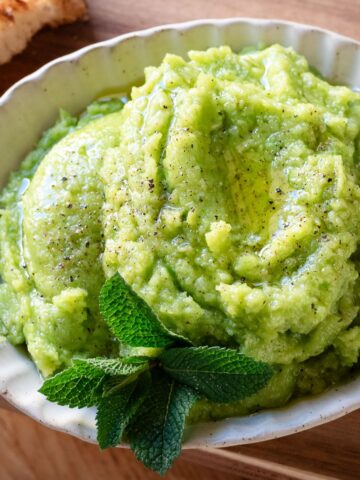



Rosemary says
The best pesto! Thanks for the tips on drying and when to cut.
Italian Recipe Book says
Thank you Rosemary! Happy to hear you found it helpful 🙂